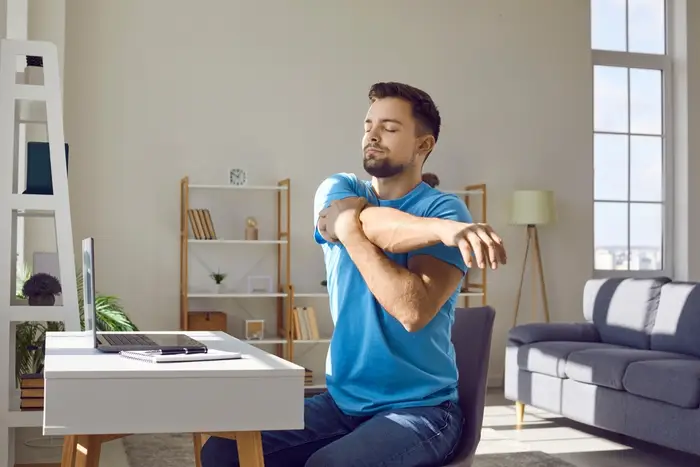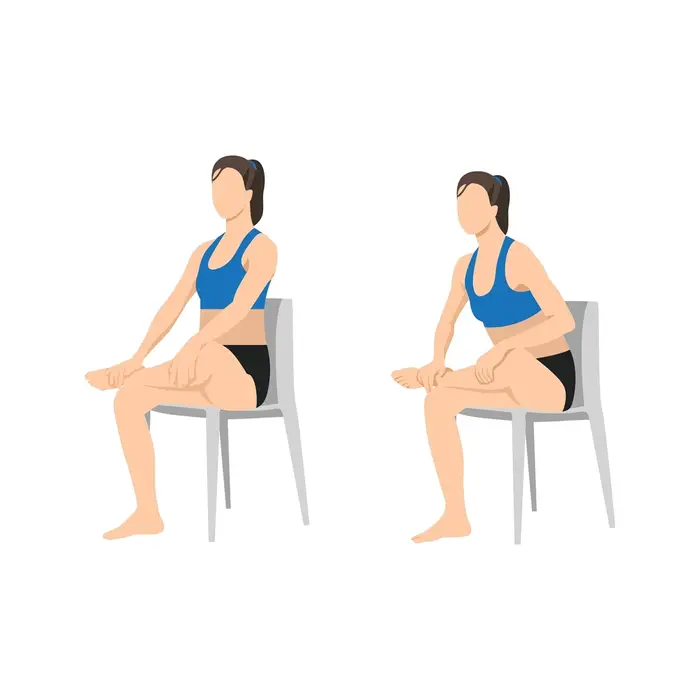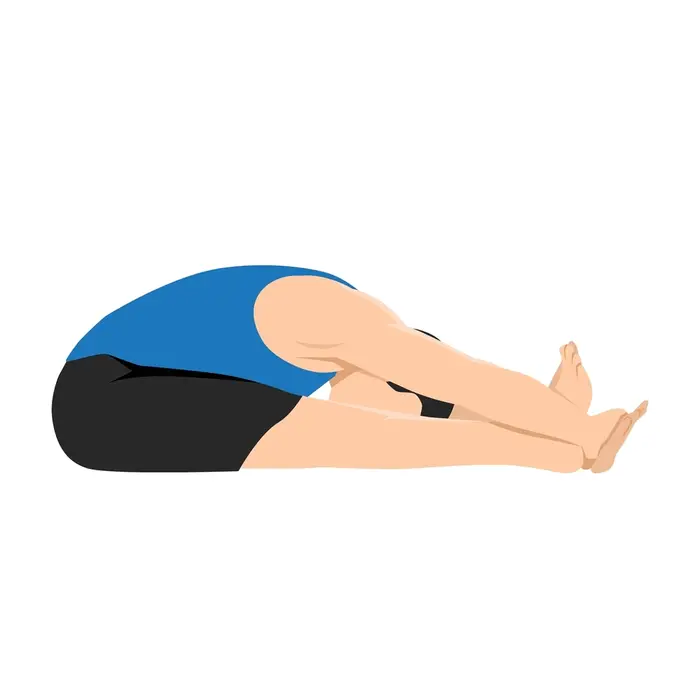10 Yoga at Your Desk Men: Relieve Stress, Improve Posture & Boost Energy at Work
After a demanding day at work, do you usually feel stiff, exhausted, or mentally drained? One potentially revolutionary answer you have been looking for could be desk yoga. In the fast-paced environment of today, when most of us spend hours seated in front of computers, physical and mental health might be subordinated. Still, adding basic yoga poses to your daily practice will transform your workday, improve your health, increase your concentration, and reduce your stress.
Men especially need desk yoga. Yoga is a complete, low-impact approach to address common health issues such back pain, poor posture, and high stress levels when sedentary employment contribute to them. We’ll discuss the advantages of desk yoga, introduce you to “10 Essential Desk Yoga Poses” and a “Chest & Heart-Opening Yoga Workout for Office Workers,” and offer doable advice on how to include these practices into your everyday life in this book.
The Benefits of Desk Yoga for Men
Extended durations of sitting can seriously damage your body and psyche. Desk yoga offers a basic yet powerful approach to offset these impacts, therefore enhancing your mental clarity as well as your physical condition.
- Essential Desk Yoga Poses to Improve Health and Focus: Common office ailments can be avoided, tension can be released, and focus can be sharpened by desk yoga positions. These brief and simple stretches are meant to fit easily into your daily schedule.
- Chest & Heart-Opening Yoga Workout for Office Workers: Common among office workers, a forward-hunched posture can cause tight chest muscles and a compressive heart space. By improving posture, opening your breathing, and increasing your energy levels, chest-opening yoga practices help to offset this.
- Mental Wellness: Desk yoga is a great tool for mental clarity and stress management in addition to being about physical health. Yoga has been found in studies to reduce cortisol levels, the stress hormone, boost mood and output, and diminish Just a few minutes of daily practice will help you to feel calmer, more focused, and ready to attack your chores.

Common Physical and Mental Challenges for Office Workers
Physical Issues
- Extended sitting might cause persistent pain by weakening your back muscles.
- Bad ergonomics and frequent screen time sometimes cause tension headaches and stiff necks.
- Hunching over your workstation produces tension and limited shoulder movement.
Mental Strain
- Deadlines and job demands can raise stress levels.
- Burnout: Constant multitasking and inadequate breaks can wear one out.
- Sitting in one posture for too long could make concentration more difficult.
How Desk Yoga Solves These Problems
One all-around answer to these problems is desk yoga. Including basic postures in your daily routine helps you to release physical tension, lower stress, and enhance your general state of health. Regardless of flexibility or degree of fitness, these positions are meant to be reachable to anyone.
10 Essential Desk Yoga Poses to Stay Active at Work
Desk yoga doesn’t call for special clothes, a yoga mat, or even much time. Everyone can do these postures right from your chair or desk, so accessibility is easy. Ten basic positions meant to release stress, correct posture, and revitalize you all through the workday are outlined here.
Pose 1: Neck Rolls
Neck rolls are simple yet effective for relieving tension in your neck and shoulders.
- Straighten your back and relax your shoulders.
- Tilt your head gently forward then roll it to one side gradually.
- Roll on in a circular direction until you complete a full circle.
- To stretch your neck, repeat five repetitions in every direction.

Pose 2: Seated Spinal Twist
The seated spinal twist is excellent for spinal alignment and flexibility.
- Keeping both feet flat on the ground, sit sideways in your chair.
- Holding the rearrest for support, twist your torso toward the rear of the chair.
- Breathe deeply then hold the twist for fifteen to thirty seconds.
- Turn sides and stretch again.

Pose 3: Desk Downward Dog
This pose stretches your shoulders, upper back, and hamstrings.
- On the border of your desk, place your hands shoulder-width apart.
- Reversing and bending at your hips will produce a 90-degree angle with your body.
- Keeping your head free, keep the position for fifteen to thirty seconds.

Pose 4: Chair Pigeon Pose
Target your tight hips with this easy stretch.
- Ground your feet flat on the floor.
- Forming a figure-four, cross one ankle over the other knee.
- To deepen the stretch, lean slightly forward while maintaining back straightness.
- Hold for fifteen to thirty seconds then turn sides.

Pose 5: Wrist and Finger Stretches
Prevent typing fatigue with this simple stretch.
- Holding your palm up, extend one arm forward.
- Pull your fingers softly back toward your body with your opposing hand.
- Hold for fifteen seconds; then, flip hands.

Pose 6: Seated Cat-Cow
Improve spinal mobility with this dynamic stretch.
- Sit on the edge of your chair with your feet flat on the ground.
- Inhale as you arch your back, lifting your chest (Cow Pose).
- Exhale as you round your spine and tuck your chin (Cat Pose).
- Repeat 5-10 times for a full stretch.

Pose 7: Forward Fold
Release tension in your lower back with this calming pose.
- Flat feet on the ground, sit on the edge of your chair.
- Inhale as you arch your back, raising your chest (Cow Pose).
- As you curve your spine and tuck your chin (Cat Pose), exhale.
- For a full stretch, repeat 5–10 times.

Pose 8: Shoulder Rolls
Shoulder rolls are great for releasing built-up tension.
- Sitting with your feet flat on the ground
- As you fold forward, inhale deeply and then exhale letting your arms and head hang naturally.
- Hold 15 to 30 seconds then gently climb back up.

Pose 9: Deep Breathing Techniques
Calm your mind and body with focused breathing.
- Sit straight then circularly roll your shoulders forward.
- Turn around and roll backward.
- Ten repetitions in each direction will help you to release your shoulders.

Pose 10: Seated Chest Opener
Counteract a hunched posture with this stretch.
- Relax comfortably while straight back.
- Deeply inhale through your nose for four counts; hold for four counts then exhale gently for six counts.
- Spend one to two minutes repeating to feel calm and re-energized.

Throughout your workday, these yoga poses are ideal for releasing tension and increasing vitality. Here is a methodical guide:
Chest & Heart-Opening Yoga Workout for Office Workers
Importance of Chest-Opening Poses
Sitting all day hunched over can strain your back muscles and narrow your chest. Opposing this, chest-opening exercises deeper respiration and improved posture.
Best Heart-Opening Stretches
- Seated Chest Opener works your shoulders and chest.
- Opens tight shoulders and arms with cow face arms stretch.
- Reverse Prayer Pose works on your chest and shoulder flexibility.
How It Helps
These stretches increase your breathing and energy flow, so improving posture and helping you to feel more awake and fresh.
Tips to Make Desk Yoga a Daily Habit
- Start Small: Each day start with one or two positions.
- Set reminders to stretch every hour using a timer or smartphone app.
- Colleagues: Involvement Motivational and responsible encouragement of your colleagues will help them.
- Design a Routine: Add yoga to your afternoon or morning break.
Expert Insights on Desk Yoga
Quotes and Testimonials
“One great way to enhance posture and release office tension is desk yoga. A few minutes every day can really make a difference.
Scientific Backing
Yoga has been found in studies to lower stress, increase focus, and improve physical condition. For instance, a 2019 study written. indicated that brief yoga exercises during the workplace greatly improved moo and drastically reduced back pain.

Addressing Common Misconceptions About Yoga for Men
- First myth: Yoga serves only for flexibility. Truth: Yoga works with tension, concentration, and strength as well.
- Second myth: You need particular tools. Actually, desk yoga calls for no particular tools or gear.
- Third myth: Yoga requires time. Actually, each desk yoga stance takes one to five minutes.
Resources for Desk Yoga Enthusiasts
- Try apps like “Yoga for Desk Workers” or “Stretchly.”
- See videos on “10 Essential Desk Yoga Poses” and “Chest & Heart-Opening Yoga Workout.”
- Tools: Think about matching your yoga practice with ergonomic seats or standing desks.
- Books: For extra ideas, peruse manuals like “Yoga for Office Workers”.
Conclusion
Desk yoga is a means to change your workday and raise your quality of life, not only a series of stretches. Just a few minutes every day will help you to relieve physical pain, lower stress, and increase output. Start little, keep consistent, and see as your happiness and health increase. Remember to explore our free resources to begin your desk yoga path right now and share this advice with coworkers!
